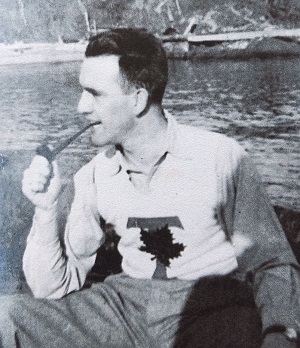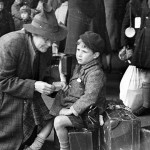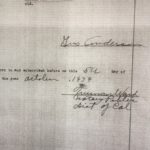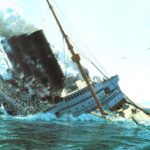The longest continuous military conflict of World War 2 – The Battle of the Atlantic –began at 7:39 p.m., Sunday, Sept. 3, 1939, when a German torpedo loaded with 600 pounds of high explosives slammed into the port side of the British passenger ship Athenia.
At that precise moment onboard Athenia, David Jennings was preparing to leave his Third class cabin near the ship’s bow to attend the third seating for dinner. A University of Toronto student returning home for his senior year, Jennings was accompanied by two university friends, Tony Cassels and John Woods, with whom he had vacationed in the British Isles the previous month. (See blog post July 16, 2015: “David Jennings: Adventures of A Young Man.”)
“Suddenly there was a dull hollow boom from somewhere aft of our cabin,” Jennings later recalled. “The lights went out immediately. The ship heeled over to port a fair amount, 10 degrees perhaps.”
They put on their coats and lifejackets, grabbed a blanket from each of their bunks, took a flashlight, and headed into the corridor for their muster station. To their great good fortune, they immediately ran into the same three young women from the University of Michigan that Jennings and Woods had met on deck only hours earlier. The three friends helped the girls into their lifejackets and accompanied them up on deck, where lifeboats were being loaded and lowered into the ocean. Jennings told the young women he thought the entire exercise was a precautionary measure.
“I still did not think it was a torpedo, merely an explosion in the engine room, and that we would all return to the ship,” he said. Jennings may have been influenced by his fellow passengers on deck, who he described as, “taking it very calmly.” The three Canadians helped the American girls into a lifeboat then assisted the crew to lower it into the water. With priority given to women and children, Jennings and his friends settled into a routine of helping people into their lifejackets and seeing them safely onto departing boats. Along about 9 p.m., with Athenia now illuminated by emergency lighting, the Canadians realized all the lifeboats had been launched. They were among only five passengers left aboard, along with about a dozen crew members, including all Athenia’s officers.
For a while Jennings and his friends joined with crew members to recover food, blankets, and lifejackets from cabins and the dining saloons belowdecks. Athenia’s list continued but the ship didn’t appear to be in immediate danger of sinking. After putting a few inflated life rafts in the water as a precaution, the men remaining on board took a breather. Food and drink were passed around, as were tobacco and matches. Jennings filled his tobacco pouch and lit a pipe he had in his jacket.
“It was a peculiar feeling,” he said. “Here were [17] men on a big 15,000-ton liner, 250 miles from shore, slowly sinking….There seemed little hope for any of us, although we never looked at it that way. Few of us, I think, and myself definitely, ever really faced the prospect of death.”
Sometime after 10 p.m. word came from the radio room that a Norwegian freighter was on its way to rescue survivors. Within the hour, Athenia’s captain, James Cook, gave the order for the rest of the men to abandon ship. Jennings, Cassels, Woods, and the two other passengers slid down a rope into a motor launch that was to offload them and several others into nearby lifeboats and return for the remaining crew.
“It was quite an experience sliding down the rope, something I had always wanted to do, although not in those circumstances,” Jennings said. The launch departed, and when they came across the first lifeboat, several passengers, including Woods, were ordered to change boats. “We called good-bye to John, not knowing when we would see him again.”
After transferring into the second lifeboat with Cassels, Jennings took a seat at an oar to help row and keep warm. Wind and a “fair-sized swell” tossed the boat and he soon became seasick for the first time in his life. The sight of lights approaching from the southwest shortly after midnight helped to dampen his queasiness with the promise of rescue.
The lights belonged to the Norwegian freighter Knute Nelson, which was about to end Jennings’ ordeal and provide a few welcome surprises, as we will see in our next blog.






